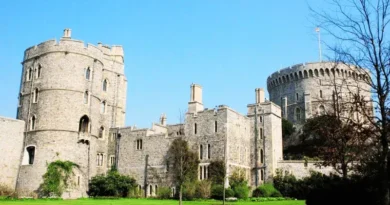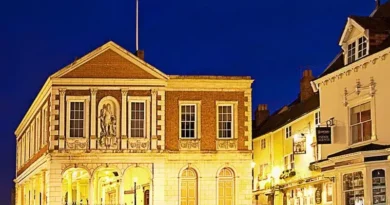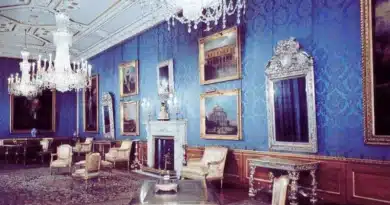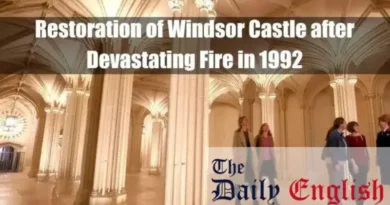What Are The Main Features Of Windsor Castle
Windsor Castle, located in Berkshire, England, is the world’s oldest and largest inhabited castle, serving as a royal residence for nearly 1,000 years. The castle features the magnificent State Apartments, adorned with opulent furnishings and art, and St George’s Chapel, a prime example of English Gothic architecture and the site of numerous royal ceremonies. The Round Tower, central to the castle’s design, houses royal archives and offers panoramic views of the surrounding area. The castle also hosts the Changing the Guard ceremony, a popular visitor attraction. Spanning approximately 13 acres, Windsor Castle remains a working royal residence, reflecting its enduring significance in British heritage.
Takeaways
| Key Points |
|---|
| Windsor Castle’s architectural layout blends medieval fortifications with later additions, balancing defence and aesthetic appeal, with its structure divided into wards to separate ceremonial and functional areas. |
| The Round Tower, originally a defensive stronghold, now houses important archives while maintaining its symbolic status, and the State Apartments, adorned with rich furnishings and historical art, serve as grand spaces for official functions. |
| St George’s Chapel, a prime example of English Gothic architecture, remains central to royal ceremonies, including weddings and services for the Order of the Garter, reinforcing tradition within the monarchy. |
| The Long Walk and castle gardens provide scenic beauty, combining formal landscaping with natural greenery, and the Great Kitchen, historically vital for royal feasts, continues to support daily castle operations. |
| The Changing the Guard ceremony, a significant royal tradition, offers a ceremonial spectacle for visitors, who can also explore the Royal Archives and Library, with select access for researchers, while guided tours, accessibility measures, and visitor amenities ensure an engaging and informative experience. |
Introduction
Windsor Castle is one of the world’s oldest and largest occupied castles. It is located in Berkshire, England, and has been a royal residence for nearly a thousand years. Originally built after the Norman Conquest, the castle has grown over the centuries to become a symbol of the British monarchy and national heritage. Today, it remains a working residence and a popular attraction for visitors.
Architectural Layout
General Structure and Design
The castle’s design is a blend of medieval fortifications and later architectural additions. Built on a natural hill, its walls and towers were originally intended for defence. Over time, more refined features were added to provide comfort and enhance the building’s aesthetic appeal. This combination of practical and decorative elements reflects the castle’s long history and changing functions.
Division into Wards
Windsor Castle is organised into several wards, each with a distinct role. The Upper Ward is the most prestigious and includes the State Apartments and St George’s Chapel, which are used for official functions and ceremonies. In contrast, the Lower Ward houses administrative offices and residential buildings. This division helps manage the castle’s many responsibilities and maintains a clear structure between its ceremonial and functional areas.
The Round Tower

Historical Background
The Round Tower is one of the castle’s most recognisable features. It was originally designed as a defensive stronghold in the early stages of Windsor Castle’s history. Its simple, circular shape was intended to withstand attacks and played a key role in the castle’s early fortifications.
Current Use and Significance
In modern times, the Round Tower has been repurposed. It now serves as a storage area for important documents and archives, preserving the history of the castle and the monarchy. Despite its change in function, the tower remains a central and symbolic feature of Windsor Castle, reminding visitors of its long and varied past.
State Apartments

Description of Rooms and Decor
The State Apartments are a series of grand rooms used for state functions and official receptions. Each room is decorated with rich furnishings, elegant tapestries, and detailed woodwork that has been maintained and updated over the centuries. These rooms’ design reflects both the castle’s history and the continued importance of tradition within the British royal household.
Notable Art and Furnishings
Visitors can view an impressive collection of art and historical artefacts within the State Apartments. Portraits of past monarchs, decorative panels, and fine furnishings all contribute to the opulent atmosphere. These pieces not only enhance the visual appeal of the apartments but also serve as a record of the artistic and cultural achievements of the British monarchy.
St George’s Chapel

Architectural Style
St George’s Chapel is a prime example of English Gothic architecture. The chapel features pointed arches, intricate stone carvings, and elegant stained glass windows. These elements combine to create a space that is both solemn and beautiful. The building has been carefully preserved, ensuring its original Gothic style remains intact despite modern restorations.
Role in Royal Ceremonies
The chapel plays a vital role in royal ceremonies. It is the spiritual home of the Order of the Garter, Britain’s oldest order of chivalry, and has been the site of many important royal events. Weddings, funerals, and investitures are often held in the chapel, linking the present-day royal family with centuries of tradition. Its continued use in state ceremonies underscores the ongoing importance of history and tradition at Windsor Castle.
The Long Walk and Gardens
Description of the Long Walk

The Long Walk is a prominent tree-lined avenue that stretches from Windsor Castle into the surrounding parkland. It provides a clear, unobstructed view of the castle and the natural scenery beyond. The avenue has been used for ceremonial processions and leisurely walks for centuries, making it a significant feature of the castle’s extensive grounds.
Overview of Castle Gardens
The castle gardens are carefully maintained areas that complement the historic architecture of Windsor Castle. They include both formal landscaped gardens and more natural, informal areas. These gardens serve as decorative features and spaces for relaxation and reflection for visitors, echoing the longstanding tradition of blending nature with history.
The Great Kitchen
Historical Importance
The Great Kitchen at Windsor Castle has a rich history as the hub of culinary activity for the royal household. In its early days, it was responsible for preparing large-scale feasts and daily meals, reflecting the importance of food in royal life and state ceremonies. Its operations played a crucial role in supporting the many functions and events held at the castle.
Current Function
Today, the Great Kitchen remains an essential part of the castle’s infrastructure, although it operates behind the scenes. While it no longer serves the same ceremonial purpose as in the past, it is still used to support the day-to-day activities of the castle, ensuring that the traditions of royal hospitality are upheld.
Changing the Guard Ceremony

Tradition and Schedule
The Changing the Guard ceremony is a time-honoured tradition at Windsor Castle. It involves a formal handover of duties between the guards, who wear ceremonial uniforms and carry out a set routine. The ceremony is scheduled regularly and forms an integral part of the castle’s daily life, symbolising the continuity of the monarchy.
Visitor Information
This ceremony is a popular event for visitors, offering a chance to witness a piece of living history. Designated viewing areas are provided to ensure that guests can enjoy the spectacle safely and comfortably, making it one of the highlights of a visit to Windsor Castle.
The Royal Archives and Library
Location within the Castle
The Royal Archives and Library are housed within a dedicated section of Windsor Castle. This area is carefully preserved to maintain the integrity of its historic documents and artefacts. Its placement within the castle underscores the importance of safeguarding the records of British heritage.
Contents and Accessibility
The archives and library contain a wealth of historical records, including official documents, manuscripts, and artefacts that chronicle the long history of the monarchy. While these collections are not fully open to the general public, access is granted to researchers and historians under strict conditions, ensuring that the materials are preserved for future generations.
Visitor Experience
Tour Options
Windsor Castle offers a variety of tour options to suit different interests. Visitors can choose from guided tours, which provide detailed historical context and insights, or self-guided audio tours, allowing for a more flexible exploration of the castle and its grounds.
Accessibility and Amenities
The castle is equipped with facilities to enhance the visitor experience. These include accessible routes for those with mobility needs, well-signposted areas, and amenities like gift shops and cafes. The aim is to ensure that every guest can enjoy the rich history and beauty of Windsor Castle with comfort and ease.
Conclusion
Windsor Castle remains a vital symbol of British heritage. Its longstanding traditions, impressive architectural features, and carefully maintained grounds offer a unique insight into the history and ongoing functions of the monarchy. Whether through its ceremonial events, historical rooms, or beautifully landscaped gardens, the castle continues to draw visitors worldwide, inviting them to experience its enduring legacy.
FAQ
What are the key features of Windsor Castle?
Windsor Castle exemplifies medieval architecture and royal opulence through its impressive State Apartments, renowned St George’s Chapel, meticulously maintained gardens, and an extensive collection of historic artefacts. One may observe that every element contributes to a comprehensive narrative of centuries of British heritage and monarchical tradition.
How are the State Apartments designed?
The State Apartments are designed with lavish interiors featuring intricate ceiling paintings, opulent furnishings, and ornate textiles. One may appreciate the refined blend of decorative arts and historical elegance evident in every detail. The rooms reflect evolving royal tastes and offer a detailed account of the monarchy’s artistic legacy.
What makes St George’s Chapel special?
St George’s Chapel is celebrated for its exemplary Gothic architecture, intricate stone carvings, and vivid stained glass windows. One may note the presence of royal tombs and ceremonial spaces that enhance its historical significance. The chapel embodies spiritual reverence and artistic mastery, offering insight into centuries of royal tradition.
What historic art is displayed at the castle?
An extensive collection of historical art is housed within the castle, including rare portraits, exquisite tapestries, and detailed murals. One may observe that each piece is carefully curated to represent significant epochs in British history, forming a visual narrative that underscores royal evolution and cultural heritage.
How do the castle gardens impress visitors?
The gardens are meticulously landscaped, featuring seasonal blooms, ancient avenues, and tranquil spaces. One may find that these outdoor areas reflect centuries of horticultural tradition and careful conservation. They provide a peaceful counterpoint to the opulent interiors while offering a harmonious blend of nature and history.
What architectural styles are represented at Windsor Castle?
Windsor Castle displays a fusion of Gothic, Baroque, and Renaissance architectural styles. One may discern the influence of medieval fortifications combined with refined ornamental embellishments. The diverse stylistic elements narrate a historical evolution of design, encapsulating the royal family’s changing tastes and artistic achievements.
What royal memorabilia is found at the castle?
An impressive array of royal memorabilia is exhibited throughout the castle, including rare portraits, ceremonial artefacts, and personal possessions of monarchs. One may observe that each item is carefully preserved, offering insights into British royalty’s personal histories and traditions and providing a tangible connection to an illustrious past.
What are the iconic exterior features of the castle?
The castle’s exterior is distinguished by imposing battlements, stately towers, and robust fortified walls. One may appreciate the harmonious blend of defensive architecture with elegant decorative details. The commanding façade stands as a testament to centuries of royal heritage and architectural innovation, symbolising enduring grandeur.
How does the Queen’s Gallery enhance the experience?
The Queen’s Gallery enhances the visitor experience by hosting rotating exhibitions of significant royal collections. One may observe that its modern design complements the castle’s historical ambience, creating a refined dialogue between contemporary art presentations and time-honoured treasures, thus offering both cultural depth and artistic insight.
What do the royal state rooms reveal about heritage?
The royal state rooms unveil an atmosphere of opulence and refined historical craftsmanship. One may observe intricate plasterwork, luxurious furnishings, and symbolic artworks that reflect centuries of ceremonial tradition. These rooms provide detailed insight into the evolution of British royal etiquette and the enduring cultural legacy of the monarchy.
How are the private quarters decorated?
The private quarters are adorned with elegant, understated décor that blends historical refinement with personal touches. One may note the careful selection of antiques and artefacts echoing the tastes of previous occupants. This intimate setting offers insight into the personal side of royal life and reflects a balanced sense of luxury and charm.
What is notable about the Changing of the Guard?
The Changing of the Guard is a ceremonious event marked by precise military traditions and elaborate ceremonial uniforms. One may observe disciplined formations and regimented movements that underscore the castle’s longstanding role in preserving royal pageantry. This ritual serves as a living exhibition of historic martial customs and national pride.
How does Windsor Castle reflect royal history?
Windsor Castle reflects royal history through its preserved architectural elements, curated collections of artefacts, and significant ceremonial spaces. One may discern narratives of monarchical evolution embedded within the structure. The castle stands as a tangible testament to the progression of British royal customs and the enduring influence of the monarchy.
What role does the castle play during state occasions?
The castle plays a central role during state occasions and royal celebrations, hosting events that underscore national pride and historical significance. One may observe that its grand halls and ceremonial spaces are utilised for formal receptions and official gatherings, thereby reinforcing its status as a premier venue for British tradition and cultural heritage.
What conservation efforts are evident at the castle?
Extensive conservation efforts are evident throughout the castle, including meticulous restoration projects and modern climate control systems. One may appreciate that every effort is taken to preserve historic walls, artefacts, and decorative details. These initiatives ensure the castle remains an authentic repository of centuries-old heritage for future generations.
What modern security measures are in place at the castle?
Modern security measures are discreetly integrated into the castle’s historic structure, with advanced surveillance systems and controlled access points in place. One may note that these features protect invaluable artefacts while preserving the integrity of the ancient fabric, thus ensuring a safe environment for visitors without compromising historical authenticity.
How accessible are the castle tours and exhibitions?
Castle tours and exhibitions are designed with visitor accessibility in mind, offering comprehensive guided tours, detailed interpretative displays, and clear signage throughout the premises. One may find that these well-structured experiences facilitate a deeper understanding of the castle’s rich history and allow for an engaging exploration of its cultural heritage.
What modern innovations enhance the visitor experience?
Modern innovations such as state-of-the-art lighting, advanced climate control, and interactive exhibition panels enhance the overall visitor experience. One may appreciate that these technological integrations complement the historic ambience while providing enhanced comfort and accessibility, thereby presenting the castle’s storied past in a refined and engaging manner.
How is Windsor Castle portrayed in popular media?
Windsor Castle is frequently featured in films, television programmes, and literature, symbolising British royalty’s grandeur and historical depth. One may observe that its iconic architecture and storied past are depicted with great reverence. This portrayal reinforces its cultural significance and global reputation as a beacon of national heritage.
What makes Windsor Castle a must-visit landmark?
Windsor Castle is an essential landmark encapsulating centuries of British royal history and architectural brilliance. One may appreciate its meticulously preserved interiors, exquisite chapels, and expansive gardens, each narrating a detailed story of heritage and tradition. The castle offers a profound cultural experience, making it an indispensable destination for history enthusiasts.









